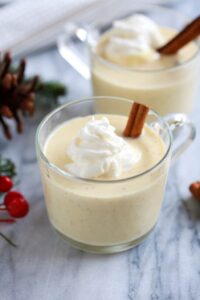
With the holidays come some of our most beloved meals and desserts – not to mention those seasonal coffee flavors! Have you ever wondered, though, why these flavors have stuck with the holidays for years and years? Let’s deep dive into the origins of our most esteemed holiday flavors.
Gingerbread
Ginger was first cultivated in China and made its way to Europe via the Silk Road (elementary history coming in handy!). Before ginger became the essential ingredient in our favorite cookie, it had many other uses such as helping to preserve meats and alleviate nausea and other ailments. Henry VIII even had a ginger concoction in hopes of preventing the plague – for himself, of course. Down the road in the 10th century, Europeans created the gingerbread cookie recipe. This staple was often sold at festivals across Europe, and they eventually had their own, known as Gingerbread Fairs.

The first gingerbread house was created in Germany in the 16th century, and its popularity skyrocketed thanks to the Brothers Grimm story of Hansel and Gretel. Before the famous fairy tale though, Russians were the first to make gingerbread men and women at Christmas, often as replicas of their friends.
Peppermint
Peppermint was first cultivated in 1500 BC for its use in herbal remedies in North Africa and the Mediterranean. However, the name peppermint originates from Greek mythology. The god of the underworld, Hades, had an affair with a nymph named Minthe. When Hades’ wife found out, she turned Minthe into a plant. Hades, feeling sad and guilty, gave Minthe a sweet scent and flavor so that others would still admire her.
Peppermint leaves have been found in Egyptian pyramids. Experts believe this was because peppermint oil was extremely valuable, and Egyptian royalty was buried with their treasures and wealth to bring into the afterlife.
 The association between peppermint and Christmas has yet to be confirmed, but legend has it that a German choirmaster asked a candymaker to replicate the shepherd’s staff from the nativity scene. Regardless, peppermint has been acknowledged as a winter flavor for centuries.
The association between peppermint and Christmas has yet to be confirmed, but legend has it that a German choirmaster asked a candymaker to replicate the shepherd’s staff from the nativity scene. Regardless, peppermint has been acknowledged as a winter flavor for centuries.
Eggnog
Dating back to 13th century Britain, eggs and milk were known as luxuries, so an eggnog-like mixture was often used for toasts, similar to champagne today.  However, us Americans were the first to drink traditional eggnog around the holidays (point America!). Nonetheless, the store bought eggnog most often served is nothing quite like the original recipe with eggs, milk, cream, and plenty of alcohol. Even George Washington had his own recipe!
However, us Americans were the first to drink traditional eggnog around the holidays (point America!). Nonetheless, the store bought eggnog most often served is nothing quite like the original recipe with eggs, milk, cream, and plenty of alcohol. Even George Washington had his own recipe!
